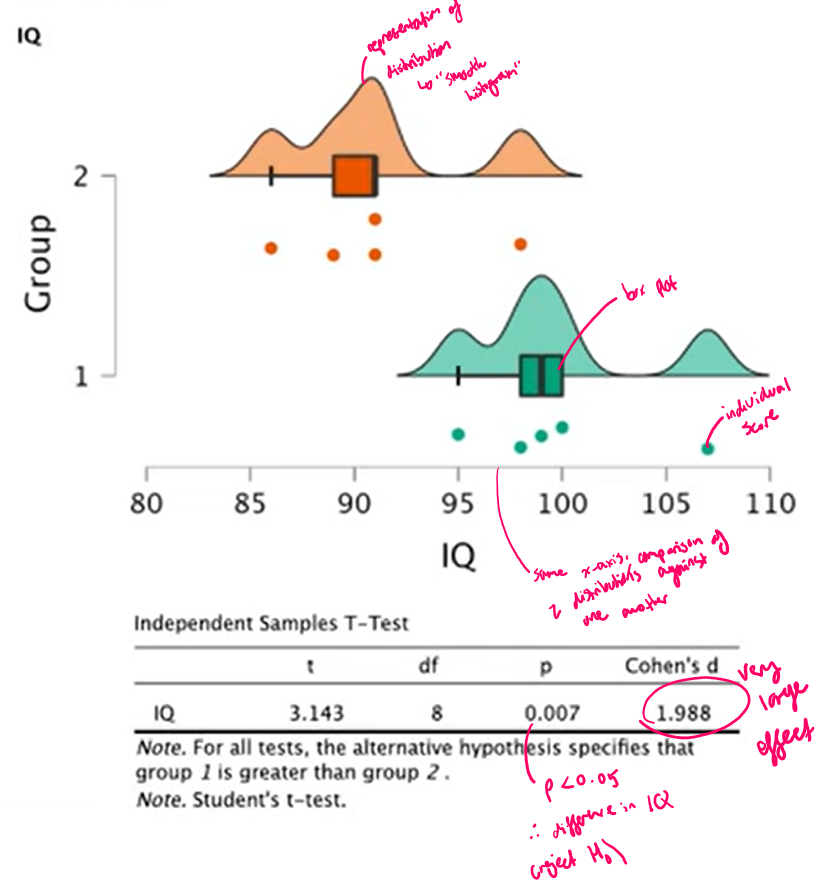RMM 7: Independent Samples t-test
1/14
There's no tags or description
Looks like no tags are added yet.
Name | Mastery | Learn | Test | Matching | Spaced |
|---|
No study sessions yet.
15 Terms
What is an independent samples t-test & what does it determine
Compares distribution of two independent samples to one another
Determines if the distributions are extremely different to each other & if the same findings could be expected in the population as a whole
What is the research design for conducting an independent samples t-test?
Research design: independent groups
Participants assigned to/come from >/= 2 different groups
Assignment to different conditions
Control & treatment
Separated based on different characteristics (e.g. eye colour)
Research question: "Is there a difference between …"
What is the difference of means?
the average values of separate groups that are represented by separate descriptive statistics
How many degrees of freedoms are used to calculate the difference of means?
n1 + n2 - 2
How is the t statistic calculated for the difference of means?
((M1 - M2) - (μ1 - μ2))/s(M1 - M2)
((Sample mean 1 - sample mean 2) - (population mean 1 - population mean 2)) / standard error (sample mean 1 - sample mean 2)
How is the difference of means calculated for the null hypothesis, & why?
H0: there is no difference in the values for the means of the two populations → μ1 - μ2 = 0
t statistic = (M1 - M2)/s(M1 - M2)
What is the standard error?
average distance b/w any given sample & the centre of its corresponding sample distribution
Function of population standard deviation & sample size
What is pooled variance & why do we need it?
Pooled variance (sp^2): the combined estimate of variance using the information from each sample
Need to combine the estimates of variance of the data from the two populations into a single value → use to calculate standard error
What is the method for calculating the pooled variance?
Combining the information on variance (sum of squares + df) from both samples into a single number
Result = weighted average of the observed sample variances (weight determined by sample size --> always falls b/w the 2 observed variances)
How is the pooled variance calculated?

JASP outputs for independent samples t-test - raincloud plot (NOT a question, just an example)

What assumption for calculating the test statistic from the pooled variance rely on, & what happens if the assumption is NOT true?
Homogeneity of variance
Assumption = some characteristic that is assumed to be true about the data, & the ability to use inferential statistics accurately & correctly (relies on the assumptions being true)
Assumptions NOT true --> analyses are ineffective & inappropriate (lots of Type I errors)
What is homogeneity of variance?
the true population variance for each group is the same and any difference in the observed sample is due to random chance
What is homogeneity of variance used to compute?
any difference in the observed sample is due to random chance
Use to compute a single pooled variance that uses df; assumption shown to not be true --> need to use a very complicated formula to estimate proper df
What happens if the homogeneity of variance is true vs violated?
Statistical programs report results of analysis assuming homogeneity of variance as true or having been violated
Corrected df (violation of HOV) = decimal places
Independent samples t-test is very robust to violations of the HOV